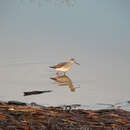en
names in breadcrumbs


A large (14 inches) sandpiper, the Greater Yellowlegs in summer is most easily identified by its mottled gray back and wings, pale breast, long straight bill, and characteristic bright yellow legs. In winter, this species becomes slightly duller-plumaged overall. This species may be separated from the related Lesser Yellowlegs (Tringa flavipes) by that species’ much smaller size and from the Willet (Tringa semipalmata) by that species’ heavily-patterned wings and bluish legs. Male and female Greater Yellowlegs are similar to one another in all seasons. The Greater Yellowlegs breeds in Alaska and the Canadian subarctic. This species is a long-distance migrant, wintering from the coasts of the U.S. south to southern South America. Greater Yellowlegs migrate through the Caribbean, along both coasts of North America, and in the interior of the continent. Greater Yellowlegs primarily breed in freshwater marshes surrounded by northern evergreen forests. In winter and on migration, this species may be found in a number of wetland habitats, including freshwater or saltwater marshes, flooded grasslands, and estuaries. Greater Yellowlegs mainly eat small fish and invertebrates, including insects, aquatic worms, and mollusks. Due to its remote breeding habitat, most birdwatchers never see Greater Yellowlegs during the summer. On migration or during the winter, this species may be seen probing the mud for food with its bill while wading in shallow water. Greater Yellowlegs are primarily active during the day.